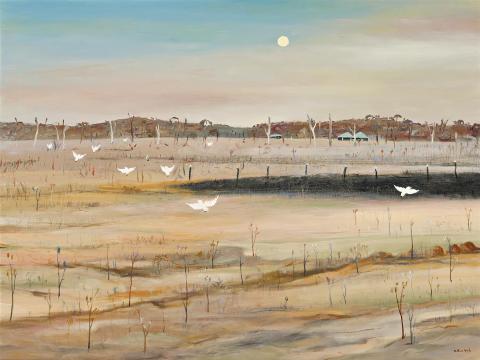WIMMERA LANDSCAPE WITH FULL MOON AND WHITE COCKATOOS, c.1985
ARTHUR BOYD
oil on board
90.0 x 120.0 cm
signed lower right: Arthur Boyd
bears inscription verso: 6 six
Savill Galleries, Melbourne (label attached verso)
Private collection, London, acquired from the above in 2000
120 Years of Australian painting, Savill Galleries, Melbourne, 3 September – 1 October 2000, cat. 44 (as ‘Wimmera Landscape with Full Moon’)
Throughout the course of his career, Arthur Boyd has been an untiring and extremely skillful and beautiful painter of landscapes. … If Boyd paints distance and the horizon it is always in a spirit of sensitivity, he wishes to reveal the appeal and delicacy of far-off things. The effects of great distance and extreme clarity of light are nostalgic, and the most everyday objects and happenings become literally transfigured.1
Boyd never endows (the Wimmera) with the drama of the desert. Even when painting its most parched and bare condition … he invariably includes some sign of life, human or animal: a ramshackle shed, scattered thin, dusty sheep, a hunter followed by his slow thirsty dog, some distant houses or even only a bird … rising or nesting.2
(In these paintings) Boyd created an archetypal Australian landscape. Possessing both a poetic lyricism and a down to earth quality and capturing the glorious light, these works … (project) a sense of acceptance that many country-dwelling Australians could identify with readily.3
Arthur Boyd first visited the Wimmera in north-west Victoria in the summer of 1948 – 1949. His paintings of the wheat-growing region, particularly those based around Horsham and Ararat, met with both critical and popular acclaim when exhibited in 1950, and their success led directly to his inclusion as one of Australia’s representatives in the 1958 Venice Biennale. Boyd revisited the theme on occasion over the following decades, painting at his property Riversdale in southern New South Wales, or at the households he established in Britain and Italy. Such was the impact of the Wimmera on his psyche that ‘every house was his studio, and the Australian landscape, strongly held in memory, was as accessible to him in his Suffolk Studio as anywhere else’.4 In Wimmera Landscape with Full Moon and Nine Cockatoos, c.1985, Boyd presents a familiar vision but one set at an unfamiliar time, namely early evening when the sky is still blue and the full moon is already prominently visible. The lights in distant houses beckon and a squall of cockatoos – the Wimmera’s most ubiquitous bird – are screeching past, catching insects for their dinner. In the middle distance, a fire-scorched patch of pasture offsets the soft green of the foreground and the scattering of pink and blue spiky plants. For the painting’s previous owner in London, such an immediately recognisable landscape would have been a source of continuing delight, memory and tangible connection to Australia.
1. O’Shaughnessy, B., ‘Introduction’, Arthur Boyd: Retrospective exhibition, Whitechapel Gallery, London, 1962, pp. 16 – 17
2. Philipp, F., Arthur Boyd, Thames and Hudson, London, 1967, p. 62
3. McKenzie, J., Arthur Boyd: art and life, Thames and Hudson, London, 2000, p. 91
4. Niall, B., The Boyds, Melbourne University Press, Victoria, 2007, p. 342
ANDREW GAYNOR
